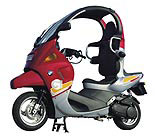Safety valves
The BMW C1 is an altogether different ride to a conventional motorcycle but it sure beats public transport

I make no bones about it. Travelling to work in London by Tube is one of life’s most humiliating experiences. Despite Ken Livingstone’s or Frank’s (have you noticed he’s dropped the Dobson bit?) reassurances of a rosier future, I refuse to take the Central Line ever again. I am sick to death of standing all the way, inhaling other people’s bad breath and cheap after shave and listening to The Chemical Brothers on someone else’s Walkman.
In a fit of rage against the Tube, following a spat with a ticket inspector, I took the plunge and bought a Gilera 50cc scooter from that daft Italian Bike Shop in Paddington Green. It is just like it is on TV, only worse. Tears and shouting all the time, lots of gesticulation and not much achieved is the order of the day. The redeeming factor is that the people there love their bikes as though they are their own children and, with scooter sales up by 77 per cent in 1999, boy, is their family growing.
No matter how much you love scooters, and I love mine, there is no such thing as a minor bike accident. Safety is the one thing that stands in the way of the market’s further expansion, consequently I’m always on the lookout for a safer, but just as nippy option.
Surprise, surprise BMW, which I view as one of motor industry’s least innovative manufacturers, has made a valiant effort to create the world’s safest motorcycle. I know sometimes I run before I walk, I recall my joy at testing the Sinclair C5, thinking it would revolutionise car transport. Well, I might have got that one wrong, but I am convinced that the BMW C1 might be the start of a new kind of transport.
BMW is using the vehicle as a way of dipping its toes in the water. It sees the C1 as a new “platform”, which, if successful, could be rolled out in a number of different guises.
It is an extraordinarily simple concept. A bike with a roof on. But it is in the implementation that the idea is so clever. You are strapped into an upright seat by a five-point harness and ahead of you is a long curving laminated windscreen which reaches up over your head. The sides are open, but your body is held in tight. So tight, in fact, that every European government thinks it’s safe enough for you not to need a crash helmet to ride it, except John “Two Jags” Prescott’s lot who, until very recently, have flatly refused to discuss the issue.
BMW’s crash tests are impressive. In a front on accident, the front wheel crumples under the body and the rider is held in place by the harness instead of ending up on the other side of the road under someone else’s car – which is the big fear of most motorcyclists. In a side-on impact, the rider is still vulnerable, but again the harness will keep you out of the way of other vehicles.
Riding the C1 is a very different experience for those who are used to the nimble handling of most bikes. The frame feels very clumsy and, since you are strapped in, you can’t shift your bodyweight as it turns corners. It is uncanny having a windscreen in front of you, but visibility is good, apart from the fact that the rear supports of the roof frame prevent you from doing a “lifesaver”, a quick glance over your shoulder every time you move your position on the road.
This is one of the most fundamental and necessary lessons that bikers are taught throughout their training. However, this is mitigated by excellent wing mirrors… but only just.
Within minutes I was completely at home riding the C1. The feeling of safety far outweighs the slightly doughy handling, and while it is marginally wider than most scooters, pretty soon I was up to my old traffic-dodging antics, running up the inside of traffic and cackling at being first off the lights, in spite of the bodywork weighing 185kg, almost twice as much as an equivalent engined Vespa.
The 125cc Rotax engine is much noisier than I expected. What a shame, as it almost justifies London’s nincompoop city planners, who are trying to get rid of free bike parking spaces in town on the basis that bikes are noisy and pollutant. However, the C1 does have the cleanest petrol engine on the road.
The big question for the C1 is, “Who will buy it?” BMW expects to sell about 1000 units in the UK. Bikers won’t like it since it has no machismo at all. Indeed, on my test run a courier asked why an able-bodied man like me was riding an “Invacar”. Car drivers may find it interesting, but few will be lured to it because it is still a bike. I think the market lies with kids, many of whom I spoke to thought it was cool and whose parents would prefer them to have a safe bike, but BMW will need to lower the price to pull them in, since the basic model costs almost £4000. It will also need to deliver some braver colours and less staid graphics.
BMW thinks women will like it, and I think that’s probably right, although it’s weight may count against it. The biggest audience for the C1 may well be people like me – those who hate public transport, want to get about everywhere quickly, and would much prefer safety over machismo every time. By the time my test run was over I really didn’t want to give it back.
Richard Williams is a director of Williams Murray Hamm.
-
Post a comment



